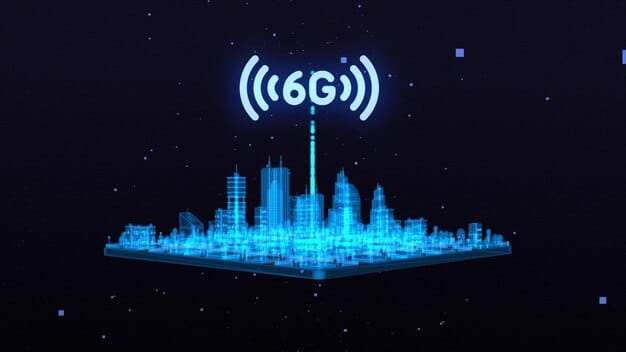Wi-Fi 7: Will the new standard revolutionize your home network in 2025?

Understanding the New Wi-Fi 7 Standard: Will It Revolutionize Your Home Network in 2025? Yes, Wi-Fi 7 may bring faster speeds, lower latency, and increased capacity; however, several factors, including adoption rates, hardware costs, and real-world performance, will dictate the extent of its impact.
The world of wireless connectivity is constantly evolving. Understanding the New Wi-Fi 7 Standard: Will It Revolutionize Your Home Network in 2025? The answer is multifaceted, but the new standard promises significant improvements over its predecessors, potentially transforming how we experience the internet at home.
What is Wi-Fi 7?
Wi-Fi 7, also known as IEEE 802.11be, is the latest iteration of the Wi-Fi standard. Built upon the foundation of Wi-Fi 6 and 6E, it aims to deliver even faster speeds, lower latency, and increased network capacity. These enhancements are achieved through a combination of new technologies and refinements to existing ones.
Key Features of Wi-Fi 7
Wi-Fi 7 introduces several key features designed to enhance wireless performance.
- 320 MHz Channel Bandwidth: Doubles the channel bandwidth compared to Wi-Fi 6, allowing for more data to be transmitted simultaneously.
- 4096-QAM (Quadrature Amplitude Modulation): Increases the amount of data that can be encoded in a single transmission, resulting in higher data rates.
- Multi-Link Operation (MLO): Enables devices to simultaneously connect to multiple frequency bands, improving reliability and reducing latency.
- Puncturing: Allows for the use of non-contiguous channels, maximizing spectrum utilization in congested environments.
Wi-Fi 7 is poised to significantly improve the wireless experience, particularly in bandwidth-intensive applications.

In summary, Wi-Fi 7 represents a significant leap forward in wireless technology, promising faster speeds and lower latency for a variety of applications.
Speed and Performance Improvements
One of the most anticipated benefits of Wi-Fi 7 is its potential for significantly faster speeds. The combination of wider channel bandwidth, higher-order modulation, and multi-link operation contributes to a substantial increase in theoretical maximum speeds.
While real-world speeds may vary depending on factors such as network congestion and device capabilities, Wi-Fi 7 is expected to deliver a noticeable improvement over Wi-Fi 6 and 6E.
Expected Speed Gains
Wi-Fi 7 boasts impressive theoretical maximum speeds.
- Theoretical Maximum: Up to 46 Gbps, a significant increase compared to Wi-Fi 6’s 9.6 Gbps.
- Real-World Expectations: While 46 Gbps may not be achievable in typical home environments, users can expect a considerable boost in speed compared to previous generations.
The increased speed of Wi-Fi 7 will enable faster downloads, smoother streaming, and improved performance in online gaming.
In conclusion, Wi-Fi 7 offers a compelling promise of faster speeds and improved performance, making it an attractive upgrade for users who demand the best possible wireless experience.
Benefits for Home Network Users
The advancements offered by Wi-Fi 7 translate into tangible benefits for home network users. From enhanced streaming experiences to improved support for multiple devices, Wi-Fi 7 is designed to meet the growing demands of modern households.
The most beneficial aspects for home users are increased capacity and throughput.
Enhanced Streaming and Gaming
Wi-Fi 7 promises to enhance both streaming and gaming.
- High-Resolution Streaming: Support for 8K and even higher resolution streaming with minimal buffering.
- Low-Latency Gaming: Reduced latency for a more responsive and immersive gaming experience.
These improvements are crucial for users who rely on their home network for entertainment and competitive gaming.

In short, Wi-Fi 7 brings several advantages for home network users, particularly those who engage in bandwidth-intensive activities such as streaming and gaming.
Challenges and Adoption Rate
Despite its potential, the widespread adoption of Wi-Fi 7 faces several challenges. Factors such as hardware costs, compatibility issues, and regulatory hurdles could impact the pace at which Wi-Fi 7 becomes commonplace in homes.
One of the first issues consumers run into is the cost of equipment.
Potential Obstacles
Wi-Fi 7 adoption may run into some obstacles.
- Hardware Costs: Early Wi-Fi 7 devices and routers are expected to be expensive, potentially limiting adoption among budget-conscious consumers.
- Compatibility Issues: Older devices may not be compatible with Wi-Fi 7, requiring users to upgrade their hardware to take full advantage of the new standard.
- Regulatory Approvals: The availability of certain Wi-Fi 7 features, such as 6 GHz band support, may be subject to regulatory approvals in different regions.
These challenges need to be addressed in order to facilitate a smooth transition to Wi-Fi 7.
In conclusion, the adoption of Wi-Fi 7 hinges on overcoming several challenges, including hardware costs, compatibility issues, and regulatory hurdles.
Wi-Fi 7 vs. Other Wi-Fi Standards
To fully appreciate the advancements of Wi-Fi 7, it’s essential to compare it with its predecessors, particularly Wi-Fi 6 and 6E. While Wi-Fi 6 brought improvements in efficiency and capacity, Wi-Fi 7 takes these enhancements to the next level with its focus on speed and latency.
The table below compares the standards in terms of data throughput.
Key Differences
Here are some key differences among Wi-Fi 7, Wi-Fi 6E, and Wi-Fi 6:
In conclusion, Wi-Fi 7 builds upon the foundation of Wi-Fi 6 and 6E, offering significant improvements in speed, latency, and capacity. While each standard has its strengths, Wi-Fi 7 is poised to deliver the best wireless experience for demanding applications.
Future of Home Networking with Wi-Fi 7
Looking ahead, Wi-Fi 7 has the potential to reshape the future of home networking. As more devices and applications demand higher bandwidth and lower latency, Wi-Fi 7 is well-positioned to meet these needs.
Virtual reality and augmented reality will require low latency and high bandwidth.
Emerging Applications
Wi-Fi 7 is a key enabling technology for emerging applications.
- Virtual Reality (VR) and Augmented Reality (AR): Support for seamless VR and AR experiences with minimal lag.
- Cloud Gaming: Improved performance for cloud gaming services, allowing users to stream games with console-quality graphics.
- Smart Home Automation: Enhanced reliability and responsiveness for smart home devices, enabling more complex automation scenarios.
These applications will benefit greatly from the capabilities of Wi-Fi 7.
| Key Aspect | Brief Description |
|---|---|
| 🚀 Speed Boost | Up to 46 Gbps, significantly faster than Wi-Fi 6. |
| 🎮 Gaming Perks | Reduced latency for smoother online gaming. |
| 🏠 Home Benefits | Improved support for streaming, VR, and smart home devices. |
| 💰 Cost Factor | Early adoption may be limited by high hardware costs. |
Frequently Asked Questions (FAQ)
▼
Wi-Fi 7-enabled devices are expected to become available by late 2024 and throughout 2025. However, wider availability will depend on chip production and device manufacturer adoption.
▼
Yes, to utilize Wi-Fi 7, you will need a new router that supports the 802.11be standard. Older routers are not compatible with the new technology.
▼
Potentially, yes. Wi-Fi 7 introduces efficiency improvements that could lead to better battery life, especially in devices that constantly use wireless connectivity.
▼
While Wi-Fi 7 routers are generally backward compatible with older devices, you will not experience Wi-Fi 7 speeds and features unless your device also supports the new standard.
▼
Wi-Fi 7 offers a theoretical maximum speed of up to 46 Gbps, which is significantly faster than Wi-Fi 6’s 9.6 Gbps. Real-world improvements will still vary based on conditions.
Conclusion
In conclusion, understanding the new Wi-Fi 7 standard reveals a promising future for home networking. While challenges to adoption exist, the potential benefits of faster speeds, lower latency, and increased capacity make it a technology to watch in 2025 and beyond.





